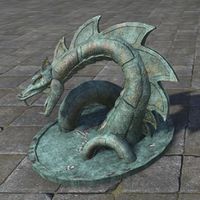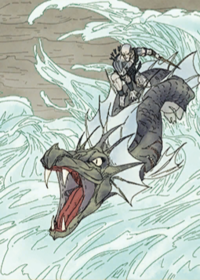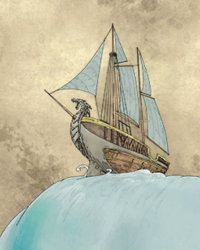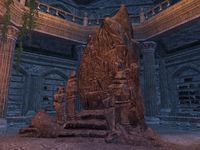Lore:Orgnum
| King Orgnum | |||
|---|---|---|---|
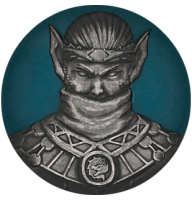 Second Era depiction of King Orgnum
Second Era depiction of King Orgnum |
|||
| Race | Aldmer/Maormer† | Gender | Male |
| Resided in | Pyandonea | ||
Orgnum (also spelled as Orghum,[1][2] and known as the "Immortal Monarch",[3] "Sorcerer-King"[4], "Serpent-king",[5] "Young King",[6] "Snake-King"[7], "Snake Wizard",[5] and formally King Orgnum, Voice of the Free Maormer People, commander of Twelve-Dozen-and-One mighty ships)[8] is the Aldmer ruler of the island kingdom of Pyandonea.[9] He is said to have a close circle regarding military matters,[10] with the core clans of Pyandonea owing loyalty to him, considered to be organized and well-disciplined in martial forces.[11] Some sources suggest Orgnum wielded a poisonous venom blade.[5]
Contents
Divinity and Nature[edit]
King Orgnum is a deathless wizard who is said to be the Serpent God of the Satakal, the Tyrant God of the Sea.[9][UOL 1] Some fanatical Maormer, such as Serpent Caller Vinsha were driven by visions of the Serpent God of Satakal.[12][13] A bevy of serpent imagery can also be found in Maormer culture from their iconography, to their weapons and armor.[14] Maormer will adorn their pendants and other jewelry with serpentine fangs in honor of their snake-king.[7] In some theories spread by guide writers for mariners, it is said that the Tyrant Orgrnum rules the Mundus itself by his Tower Flotillas, rather than the keepers of White-Gold Tower.[UOL 1]
Along with this is the presence of Sea Serpents who help supplement the Pyandonean Armada force, and thanks to Orgnum's Snake Magic, also double as occasional mounts for the Maormer and Orgnum himself.[9][15][16]
Some Maormer are even said to take place in unholy sorcerous coupling with Sea Serpents, resulting in the Maormer Leviathan hybrids. These Leviathans share an appearance of elf and serpent and when standing at full height tower over other races.[17]
Beyond the worship and reverence by his chosen people the Maormer, there is also a Redguard cult known as 'the Satakal' who are said to worship Orgnum.[9] This cult is known to go nude and perform snake like actions and movements in honor of their god, and in more extreme cases, rituals involving "shedding" of the skin.[18] This Satakal cult is viewed as a group of fringe madmen for their traditions.[18] Some Redguards maintain that their Serpent God once dwelled on their ancestral homeland of Yokuda but did not survive the journey to Hammerfell. This tradition lives on in the form of a holiday in Satakalaam that honors this Serpent God, known as Serpent's Dance.[19] Traditional Redguards view Orgnum's connection to Satakal as blasphemous, and maintain that Orgnum will not be spared at the coming of the true Satakal.[20]
It is said every attack launched by the Maormer against Summerset has been led by Orgnum himself, who it seems is not only immortal but grows more youthful by the century.[15] He is said to achieve this everlasting immortality with a combination of foul spells, rituals, and sacrifices.[16][21] Some outsiders attribute his eternal youthfulness and immortality to Vampirism.[22] He is credited in some legends with being the first person to work silver in Tamriel.[22] If there is truth to this, it would imply an unknown stretch of Orgnum's early history that he spent in Tamriel.
Numerous tales among a variety of cultures are associated with King Orgnum, such as that of Gjadil the Keel-Hauler, an explorer who sailed from Atmora and raided the palace of King Orgnum himself, burying the treasure at Dusk.[23] The Khajiit remember Nurarion the Perfect, a member of the Sunhold royal family and of Khunzar-ri's Kra'jun, who made a deal with Clavicus Vile for great powers to fight off Orgnum's forces.[6] The Altmeri play The Bright Blade of Captain Castatil tells of the protagonist going to confront Orgnum, whom he believes killed his father, only for Orgnum to remove his blue facepaint and reveal himself as his father Eroldalin, leaving no choice but for Captain Castatil to kill his father for his atrocities.[5]
Appearance[edit]
Due to Orgnum being a mysterious figure and having limited interactions with Tamriel, descriptions of his appearance come largely from outside accounts and legends. Orgnum is described as a large, imposing figure[24] with white limpid jelly-like skin and bald white eyes.[25] He is said to appear more youthful with each passing year.[15] He is often depicted as having three hands on tapestries.[26] He is described with many snake epithets, and some sources indicate he possesses serpentine fangs.[7] Some depictions of Orgnum have him sharing traits of the Maormer Leviathan, with elvish traits coupled with snake like eyes, and scales, along with a garb that consists of a cloak, a turban like head covering, and a chest piece with a serpent pendant.[27] Other sources indicate that Maormer potentially have depictions of Orgnum as a full fledged Sea Serpent in his own right.[26]
History[edit]
Origin[edit]
According to legend, Orgnum was a phenomenally wealthy Aldmer nobleman, who used his finances to launch a rebellion against the powers of the land.[28][15] He and his followers were banished for this to a place separated from Aldmeris by an impenetrable mist, Pyandonea, "The Veil of Mist". This boundary proved so effective that the followers of Orgnum never again disturbed their former countrymen in Aldmeris.[15][29] Orgnum was said to have had an affair with Kinlady Heinarwe, who was so ashamed that she forsook name, title, and clan, banished all family and servants from the hall of her place, snuffed every candle and chandelier, and withdrew, alone, into her vaults.[30]
War of the Isle[edit]
Three months before the War of the Isle in 3E 110, King Orgnum met with Potema Septim in Solitude to make an agreement that when the Maormer took over Tamriel, she would be Empress of the continent. In turn, Potema promised that she would lead an insurrection against her brother, Emperor Antiochus Septim. On the night of their first meeting, Potema shared her bed with Orgnum, as she deemed it to be the polite and diplomatic thing to do.
King Orgnum's translator was fluent in the languages of four continents; his own country of Pyandonea, as well as those of Atmora, Akavir, and Tamriel.[25]
The War of the Isle was the last documented appearance of Orgnum and the Maormer.[15] The united alliance of the kings of Summerset and Antiochus Septim,[1] combining the Imperial fleet and the royal navies of Summerset Isle, together with the magical powers of the Psijic Order, succeeded in destroying the Pyandonean invading armada.[31] It was said that the storm brewed by the Psijics of Artaeum so annihilated Orgnum's fleet that he was never again able to muster together enough of a force to dare another battle.[2][15]
King Orgnum's Coffer[edit]
King Orgnum's Coffer is a small-sized chest, ordinary in appearance. It is remarkably light, almost weightless, which offers a clue to its true magic. Once a day, the Coffer will create gold from naught. When King Orgnum himself possessed the Coffer, the supply within was limitless. He was said to have lost the Coffer in a marine battle against the Empire, led by emperor Antiochus Septim, and there are those that believe that for this reason, he could no longer afford his large fleet.[32] Those who have found it since the report that the Coffer eventually disappears after having dispersed enough gold to shame even the wealthiest of merchants. Where and why it vanishes is still a mystery. It was last seen in the hands of the Eternal Champion.
Gallery[edit]
Note[edit]
- Though Orgnum is the ruler of the Maormer, referred to with Maormeri titles, and depicted with Maormeri features, his historical migration from Aldmeris would place him as an Aldmer. The truth may lie somewhere in between, as the Aldmer physically changed over time as they dispersed throughout Tamriel and beyond.
- Orgnium is a mysterious light metal possibly named after Orgnum.
- One of the pieces of the Tales of Tribute, a popular card game originating from the Systres Archipelago played continent-wide during the Interregnum in Second Era[33] bore the image of Orgnum. A deck themed after him and his people was part of the game.[34]
References[edit]
- ^ a b Brief History of the Empire v 1 — Stronach k'Thojj III
- ^ a b Fragment: On Artaeum — Taurce il-Anselma, 3E 400
- ^ The Unveiled Azadiyeh Answers Your Questions — The Unveiled Azadiyeh
- ^ Overheard dialogue of Storm Sharks in ESO
- ^ a b c d The Bright Blade of Captain Castatil: Scene VI
- ^ a b Moon-Singer Feziya-ko's dialogue in ESO
- ^ a b c Steel Serpent Fangs antiquity description in ESO
- ^ Treaty of Khenarthi's Roost
- ^ a b c d Pocket Guide to the Empire, 1st Edition: The Wild Regions — Imperial Geographical Society, 2E 864
- ^ War Weather
- ^ Crafting Motif 64: Pyandonean Style — Telenger the Artificer
- ^ Druid Farel's dialogue in ESO
- ^ Serpent Caller Vinsha's dialogue in ESO
- ^ Crafting Motif 64: Pyandonean Style — Telenger the Artificer
- ^ a b c d e f g Pocket Guide to the Empire, 3rd Edition: Other Lands — Imperial Geographical Society, 3E 432
- ^ a b Fang of the Sea Vipers — Telenger the Artificer
- ^ The Scaled Elves — Marin Laroix
- ^ a b Pocket Guide to the Empire, 1st Edition: Hammerfell — Imperial Geographical Society, 2E 864
- ^ Holidays of the Iliac Bay — Theth-i
- ^ The Unveiled Azadiyeh Answers Your Questions — The Unveiled Azadiyeh
- ^ Sorcerer-King Orgnum's patron description in ESO
- ^ a b Sea Silver Chain in ESO
- ^ Igeke Rat-Bite's dialogue in ESO
- ^ Who Are the Sea Elves? — an unknown Breton child
- ^ a b The Wolf Queen, v4 — Waughin Jarth
- ^ a b Maormeri Serpent Shrine codex entry
- ^ Sorcerer-King Orgnum's patron appearance in ESO
- ^ The False Revanchism of the Maormer — Hadendril of Skywatch
- ^ The Maormer of Pyandonea — Imperial Geographical Society
- ^ The Vaults of Heinarwe Loading screen - The Infamy of Heinarwe
- ^ The Wolf Queen, v5 — Waughin Jarth
- ^ King Orgnum's Coffer in Arena
- ^ The Secret Origins of Tribute — Brunile Dufont, Games Scholar
- ^ Tales of Tribute: Series One — The Founders
Note: The following references are considered to be unofficial sources. They are included to round off this article and may not be authoritative or conclusive.
|
||||||||
